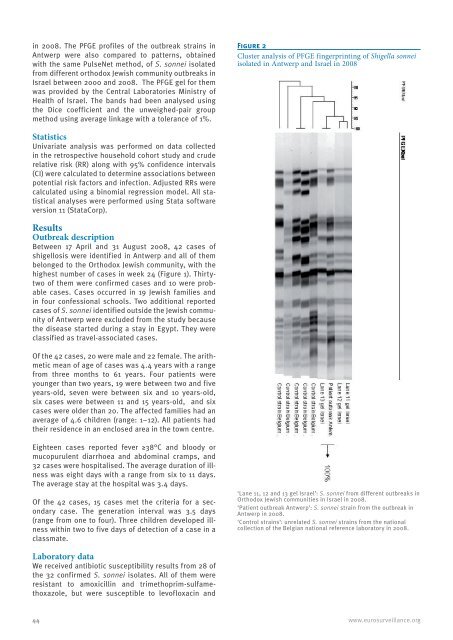Escherichia coli - Eurosurveillance
Escherichia coli - Eurosurveillance
Escherichia coli - Eurosurveillance
Create successful ePaper yourself
Turn your PDF publications into a flip-book with our unique Google optimized e-Paper software.
in 2008. The PFGE profiles of the outbreak strains in<br />
Antwerp were also compared to patterns, obtained<br />
with the same PulseNet method, of S. sonnei isolated<br />
from different orthodox Jewish community outbreaks in<br />
Israel between 2000 and 2008. The PFGE gel for them<br />
was provided by the Central Laboratories Ministry of<br />
Health of Israel. The bands had been analysed using<br />
the Dice coefficient and the unweighed-pair group<br />
method using average linkage with a tolerance of 1%.<br />
Statistics<br />
Univariate analysis was performed on data collected<br />
in the retrospective household cohort study and crude<br />
relative risk (RR) along with 95% confidence intervals<br />
(CI) were calculated to determine associations between<br />
potential risk factors and infection. Adjusted RRs were<br />
calculated using a binomial regression model. All statistical<br />
analyses were performed using Stata software<br />
version 11 (StataCorp).<br />
Results<br />
Outbreak description<br />
Between 17 April and 31 August 2008, 42 cases of<br />
shigellosis were identified in Antwerp and all of them<br />
belonged to the Orthodox Jewish community, with the<br />
highest number of cases in week 24 (Figure 1). Thirtytwo<br />
of them were confirmed cases and 10 were probable<br />
cases. Cases occurred in 19 Jewish families and<br />
in four confessional schools. Two additional reported<br />
cases of S. sonnei identified outside the Jewish community<br />
of Antwerp were excluded from the study because<br />
the disease started during a stay in Egypt. They were<br />
classified as travel-associated cases.<br />
Of the 42 cases, 20 were male and 22 female. The arithmetic<br />
mean of age of cases was 4.4 years with a range<br />
from three months to 61 years. Four patients were<br />
younger than two years, 19 were between two and five<br />
years-old, seven were between six and 10 years-old,<br />
six cases were between 11 and 15 years-old, and six<br />
cases were older than 20. The affected families had an<br />
average of 4.6 children (range: 1–12). All patients had<br />
their residence in an enclosed area in the town centre.<br />
Eighteen cases reported fever ≥38°C and bloody or<br />
mucopurulent diarrhoea and abdominal cramps, and<br />
32 cases were hospitalised. The average duration of illness<br />
was eight days with a range from six to 11 days.<br />
The average stay at the hospital was 3.4 days.<br />
Of the 42 cases, 15 cases met the criteria for a secondary<br />
case. The generation interval was 3.5 days<br />
(range from one to four). Three children developed illness<br />
within two to five days of detection of a case in a<br />
classmate.<br />
Laboratory data<br />
We received antibiotic susceptibility results from 28 of<br />
the 32 confirmed S. sonnei isolates. All of them were<br />
resistant to amoxicillin and trimethoprim-sulfamethoxazole,<br />
but were susceptible to levofloxacin and<br />
Figure 2<br />
Cluster analysis of PFGE fingerprinting of Shigella sonnei<br />
isolated in Antwerp and Israel in 2008<br />
‘Lane 11, 12 and 13 gel Israel’: S. sonnei from different outbreaks in<br />
Orthodox Jewish communities in Israel in 2008.<br />
‘Patient outbreak Antwerp’: S. sonnei strain from the outbreak in<br />
Antwerp in 2008.<br />
‘Control strains’: unrelated S. sonnei strains from the national<br />
collection of the Belgian national reference laboratory in 2008.<br />
44 www.eurosurveillance.org

















